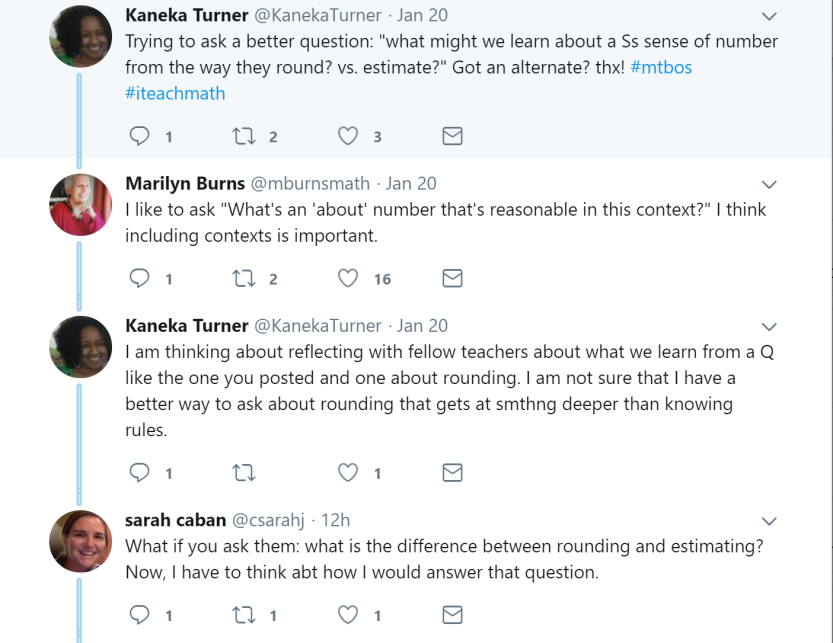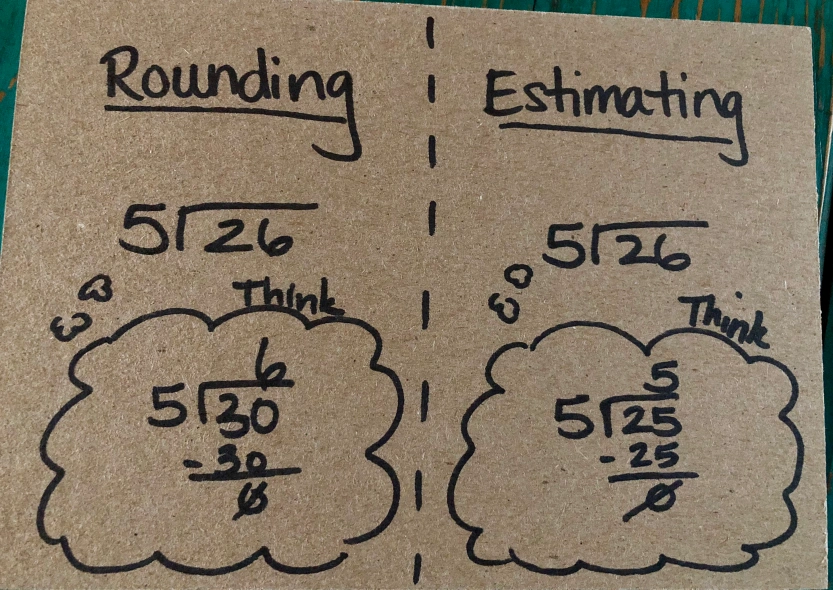As many of my blogs are born, a conversation of Twitter got me thinking. Is there a difference between rounding and estimation? If so, how do you describe it?

As I consider these two concepts, they seem similar as they both help students consider whether their answer is reasonable. This is such an important ability to develop in young mathematicians! However, I think it is also important to clearly define how estimation and rounding are the same and different for both teachers and students.
It seems that many teachers focus heavily rounding, especially the “rules of rounding”, and perhaps this is because rounding is called out so directly in both the 3rd and 4th grade Operations and Algebraic thinking standards.
3.OA. 8 Solve two-step word problems using the four operations. Represent these problems using the equations with a letter standing for the unknown quantity. Assess the reasonableness of answers using mental computation and estimation strategies including rounding.
Perhaps they focus there more as well because the rules are very clear. In rounding you must ask yourself one very important question: Is my number closer to this or that? Note my avoidance of this “5 or more, up the score” and “4 or less, clear the mess” business. While it is a catchy jingle, it has nothing to do with the place value reasoning students need to be successful in mathematics. Instead, I consider a number line (oriented horizontally or vertically) with the midpoint identified so that students can see whether it is closer to this or that.

Seeing is believing, after all.
So, if this is rounding, what is estimation? It is my opinion that rounding is a form of estimation, but it is far too rigid to only be rounding. Here is the official definition of rounding:

If I think about estimation as a rough calculation, then I have to be much more flexible in how I think about estimating a number. There is no rule for estimation. Instead, there is just the idea that by engaging on the act of estimation, I will find an “about number”. This feels like a much more rigorous skill to teach. When considering how to estimate a number you must ask yourself two questions:
- What do I know about my number(s)?
- What number(s) is close to mine that best helps me think about the reasonableness of my answer?
Let’s consider the context of division. How many of us have seen students give us unreasonable answers when dividing two numbers? I know I have! For example, what if I asked students to solve this problem?

While it is important that students understand how to find the precise answer, it is also important for students to be able to consider an “about answer”, or to estimate. Of note in this example is that rounding would make this about answer less precise (6) than estimating might (5).

Are estimation and rounding different? Yes, though they serve a similar purpose in math. Is it critical that we teach student to be flexible enough to use the strategy that best serves their needs. Absolutely! Perhaps we can consider estimation and rounding as math tools. As Standard for Math Practice 5 states, students must choose tools strategically. Let’s all be sure to put both these tools in their tool belt and help them get ever better at choosing the best tool for the situation.


I sometimes think of rounding as a helper for Estimation. I’ll round my numbers so I can do a calculation to get an estimation of the answer. For example, if I want to wallpaper my wall that’s 12’8” by 9’6” I’ll round the measurements to 13’ by 10’ and then say my square footage is about 130.
I was talking to my husband about it and he said, “Rounding is a Subset of Estimation. You round one number but estimation usually involves more than one number. Like if you’re estimating the number of people in a room you need to count something (a table or row) then you might round that number and multiply to get your estimate.”
I loved reading your thoughts on the differences, it is hard to define! When I saw your example of 26/5 I thought “I’d round 26 to 25”, I didn’t think of rounding to either 20 or30. So my rounded answer was the same as my estimated answer!
LikeLike
It seems that the differences are small but important! I love the idea of rounding being a subset of estimation. That makes perfect sense to me.
LikeLiked by 1 person
Love your explanation and reminding me that estimation and rounding are a tool to be used strategically
LikeLiked by 1 person
Great post! I think that an important aspect of estimation is recognizing when estimation is needed versus a more precise answer. I like to think that estimation is needed in two main contexts: 1) when we don’t need an exact answer (e.g., estimating how much clothes will cost at a store) and 2) when an exact answer is impractical or impossible to determine (population of a city). I think this notion of why we estimate and under what circumstances we estimate is sometimes lost in the shuffle.
LikeLike